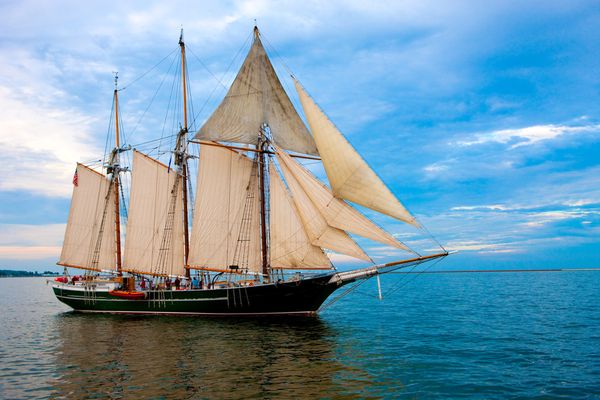4.1.2
Exploration & Trade
Henry VII and Exploration
Henry VII and Exploration
Christopher Columbus, on behalf of Spain, discovered the New World in 1492. This led Henry VII to demand English exploration as well. But English exploration in the Americas was not very successful.


Exploring the Americas
Exploring the Americas
- From 1492, Spain developed rich colonies in southern America, providing it with resources and markets.
- Henry VII encouraged the Cabots to explore America for England.
- They discovered Newfoundland and the Hudson Bay in the far north.
- Newfoundland and Hudson Bay were not wealthy. But Henry VII's successor, Henry VIII, ignored them.
Exploration and Colonisation During Elizabeth I's Reign
Exploration and Colonisation During Elizabeth I's Reign
By the end of Elizabeth I's reign, England was established as a seafaring nation. But England's exploration damaged her relations with Spain.


Sir Francis Drake
Sir Francis Drake
- Between 1577-1580, Drake became the first person to circumnavigate the globe. This included raiding Spanish ports in the Americas, and losing several ships from his fleet in storms around the globe.
- For example, he captured £40,000 of Spanish treasure in Panama.
- He was knighted on his return. The wealth from Drake’s travels and his knighthood encouraged more British sailors.
- Elizabeth I also took a large chunk of the treasure that Drake brought home from his journey.


Sir Walter Raleigh
Sir Walter Raleigh
- In 1584, Elizabeth I gave Sir Walter Raleigh permission to colonise (seize control of) any part of the Americas not ruled by Christians.
- In fact, he sent others to try to establish the colonies there (like New Albion in California). Humphrey Gilbert's tried to create a colony in Newfoundland, Canada, but he failed.
- But the colonies established on the east coast of America in the 1580s did not last.


Sir John Hawkins
Sir John Hawkins
- In 1562 and 1564, Hawkins made profits from the Triangular Trade for figures such as Cecil, Leicester and Elizabeth I.
- In 1568, his ships were attacked by the Spanish in Mexico. This was in response to him trying to break Spain’s monopoly in the trans-Atlantic slave trade.


The Lost Colony
The Lost Colony
- In 1585, Raleigh set up a colony on Roanoke Island, Virginia. But most of the 108 settlers returned to England in 1586. By 1590, there was nobody in the colony.
- Roanoke Island was then called the Lost Colony. There were not enough supplies and Roanoke did not have good land for farming.
Exploration and Trade Under Elizabeth I
Exploration and Trade Under Elizabeth I
Empire-building began with Elizabeth I. Her empire was largely driven by international trade.


Transatlantic trade
Transatlantic trade
- Exploring the New World was contentious because Spain and Portugal claimed it.
- In 1562 and 1564, John Hawkins made large profits from the Triangular Trade.
- Drake conducted raids against Spanish ships and colonies in the New World. He brought back huge sums in 1572-3 and after his circumnavigation 1577-80.


Angering Spain
Angering Spain
- Elizabeth hoped English privateers could distract Spain as well as disrupt its flow of silver and resources from America. Instead, they angered him.
- Spain attacked John Hawkins’ fleet in 1568 for trying to break Spain’s monopoly in the trans-Atlantic slave trade.


Rivalry and relevance of Antwerp
Rivalry and relevance of Antwerp
- In 1550, most of England’s trade was exporting wool to Antwerp (which was a port controlled by Spain).
- As relations with Spain got worse, trading through Antwerp became harder.
- This encouraged exploration and the discovery of new trade routes.


Trading companies
Trading companies
- The East India Company was created in 1600 and it had a monopoly to trade with Asia.
- Trade with Asia was helped when James Lancaster discovered a route to Asia around the Cape of Good Hope (South Africa) to Asia.
- The Spanish company was created and had a monopoly on trade with Spanish colonies.
- The Muscovy Company helped break the monopoly of the Hanseatic League in the Baltic.
1Monarch & Government
1.1Tudor Monarchs
1.2Changing Role of Parliament
1.3Principal Servants to the Crown
2Religious Changes
2.1Tudor Monarchs & Religious Change
2.2Catholicism & Survival
2.3Protestantism & Puritanism
3State Control & Popular Resistance
3.1Tudor Control of the Country
3.2The State & the Poor
4Economic, Social & Cultural Change
4.1Patterns of Domestic & Foreign Trade
4.2Changing Structure of Society
5Historical Interpretations
5.1Significance of Threats to National Security
5.2Court Politics
5.3Elizabeth & Parliament
5.4Social Distress in the 1590s
Jump to other topics
1Monarch & Government
1.1Tudor Monarchs
1.2Changing Role of Parliament
1.3Principal Servants to the Crown
2Religious Changes
2.1Tudor Monarchs & Religious Change
2.2Catholicism & Survival
2.3Protestantism & Puritanism
3State Control & Popular Resistance
3.1Tudor Control of the Country
3.2The State & the Poor
4Economic, Social & Cultural Change
4.1Patterns of Domestic & Foreign Trade
4.2Changing Structure of Society
5Historical Interpretations
5.1Significance of Threats to National Security
5.2Court Politics
5.3Elizabeth & Parliament
5.4Social Distress in the 1590s
Unlock your full potential with Seneca Premium
Unlimited access to 10,000+ open-ended exam questions
Mini-mock exams based on your study history
Unlock 800+ premium courses & e-books